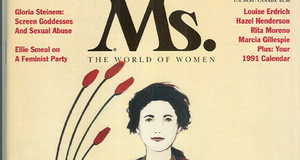Featured Article:The Media's Sexualization of Female Athletes: A Bad Call for the Modern Game
By
2011, Vol. 3 No. 10 | pg. 2/2 | « Out of Bounds: Challenges for the Feminist Movement and Future RamificationsBy provoking women into hostility with each other, the media’s sexualization of female athletes poses a challenge for the feminist movement. Athletes may feel empowered when reporters comment on their sex appeal or when the media show off their bodies in sexy poses, but they do not accurately represent women, who cannot gain much from their publicity. After analyzing the textual portrayals of female athletes in television commercials and print advertisements, Victoria Carty, an assistant professor of sociology at Niagara University in New York, concluded that “although athletes who use nudity may gain financially and take pride in their individual success, they are not necessarily acting on behalf of other women to enhance the collective position of women in society” (152). If women in general feel that athletes are selfishly neglecting their own gender, they will be less likely to support women’s sports. Modernist feminism echoes this principle. For example, Gloria Steinem, whose experience as the co-founder of the American feminist magazine Ms. gives her much insight into the media’s treatment of women, asserts that “perhaps…the worst punishment ad influence has inflicted upon us [is] made us feel contemptuous of other women” (126). If a deep division between women exists, the feminist movement can face difficulty in mobilizing and advancing goals not just in athletics, but in other institutions as well. Because the media’s sexualization of female athletes promotes male superiority, the feminist movement also faces the perpetuation of a patriarchal society. Compelling female athletes to become sexualized and passive, the media essentially “combine notions of feminism and traditional stereotypes of femininity” to reinforce male dominance (Carty 152). If the media prolong the idea that female athletes are inferior to male athletes, a “fundamental barrier to any significant change with respect to conceptions of the female athlete and her body” will continue to exist (Buysse and Embser-Herbert 79). Opponents like Boswell and Thompson may claim that female athletes may actually have the power because the media is giving them publicity and money for their powerful, beautiful bodies. However, these benefits are merely “within the confines of the patriarchal structures that organize and control society” (Carty 152). Even though female athletes may attempt to introduce new views on strength and sexuality into society, they ultimately only maintain a traditional and restrictive patriarchal society. Such perpetuation could undo the progress of the first and second waves of feminism, regressing society into a Victorian-style era in which the “tyranny of the patriarchal state” will control women (Woolf 102). This extreme relapse may seem unlikely, but any movement away from progress nonetheless takes away from the status and efforts of women in general. Through sexualizing female athletes, the media entrench society’s patriarchal structure, which undermines the feminist movement’s attempt to achieve gender equality and greater opportunities for women. Therefore, although female athletes who accept their objectification may feel empowered and complimented because they are requested to show off their exemplary and hard-earned bodies, the media’s sexualization comes at an individual and social cost. Not only do the athletes jeopardize their self-confidence, identity, and spiritual growth and do the media compromise their ability to faithfully report on sporting events, but society also regresses further into patriarchy. Even those who oppose such portrayals end up alienating themselves from society and their peers, so only an extensive opposition can alleviate the problem. Just as the media’s sexualization poses problems for female athletes, it creates significant obstacles for the viewers and the feminist movement, prolonging the cycle of marginalization and even ignorance of women’s sports. As long as the media continues to sexualize female athletes, women in general will remain in a less powerful role, and feminist ideals of gender equality cannot be fully realized. Even outside of sports, women are frequently marginalized and objectified, as society tends to undermine their accomplishments in favor of their beauty and sex appeal. Although the feminist movement and its supporters have enacted momentous, widespread changes, gender discrimination is still prevalent in employment, politics, and education. The American public often ridicules women who challenge these conditions as aggressive and sex-deprived, further perpetuating an antifeminist stereotype and obstructing the goals of feminism. Thus, the media’s sexualization of female athletes does not just exemplify the present condition of life for women, but is a symptom of the root problems of a patriarchal American society.This issue leads to a consideration of potential solutions to the media’s sexualization of female athletes and their implications for modern American society. To increase the status of female athletes and women in general, actions must build up from an individual and local level. If most, ideally all, female athletes refuse to follow the media’s sexualization, they can fulfill Modernist feminist ideals without compromising material benefits. Eventually, their actions would encourage the media to emphasize their athletic performances, garnering themselves positive publicity and empowerment. Because sports constitute a large part of American culture, the media can continue to make profit without sexualization, and athletes who pose for nonsexualized magazines and items in popular culture can still earn a large amount of money, perhaps even more than from sexualized portrayals. At a local level, communities should create more youth coed sports. Boys and girls would learn respect for each other as well as teamwork, so men would be more likely to see women as equals instead of inferiors. Achieving gender equality in sports can lead to corresponding progress in other institutions of the 21st century and beyond, successfully freeing American society from the “feminist mystique” (Friedan 267) and the “tyranny of a patriarchal state” (Woolf 102). ReferencesAmerican Psychological Association. “Task Force on the Sexualization of Girls.” Report on the APA Task Force on the Sexualization of Girls. Washington, D.C.: American Psychological Association, 2007. 19 Oct. 2010 < http://www.apa.org/pi/women/ Boswell, Laura. “Olympians Posing Nude, Poses Questions.” ESPN. 13 Oct. 2004. 18 Oct. 2010. Buysse, Jo Ann M. and Melissa Sheridan Embser-Herbert. “Constructions of Gender in Sport: An Analysis of Intercollegiate Media Guide Cover Photographs.” Gender and Society 19.1 (2004): 66-81. JSTOR. ITHAKA. Cecil H. Green Lib., Stanford, CA. 19 Oct. 2010 . Cahn, Susan K. Coming on Strong: Gender and Sexuality in Twentieth-Century Women’s Sport. New York: The Free Press, 1994. Carty, Victoria. “Textual Portrayals of Female Athletes: Liberation of Nuanced Forms of Patriarchy?” Frontiers: A Journal of Women Studies 26.2 (2005): 132-155. Academic Search Premier. EBSCOhost. Cecil H. Green Lib., Stanford, CA. 9 Nov. 2010 . Daniels, Elizabeth A. “Sex Objects, Athletes, and Sexy Athletes: How Media Representations of Women Athletes Can Impact Adolescent Girls and College Women.” Journal of Adolescent Research 24.4 (2009): 399-422. SAGE Journals Online. SAGE. Cecil H. Green Lib., Stanford, CA. 17 Oct. 2010. Friedan, Betty. The Feminine Mystique. New York: W.W. Norton and Company, 1963. Harvard Law Review. “Cheering on Women and Girls in Sports: Using Title IX to Fight Gender Role Oppression.” Harvard Law Review 110.7 (1997): 1627-1644. JSTOR. ITHAKA. Cecil H. Green Lib., Stanford, CA. 17 Oct. 2010 origin=JSTOR-pdf>. Interviews with Betty Friedan. Ed. Janann Sherman. Jackson: UP of Mississippi, 2002. MacKinnon, Catherine. Only Words. Cambridge: Harvard UP, 1993. Messner, Michael A., Margaret Carlisle Duncan, and Kerry Jensen. “Separating the Men from the Girls: The Gendered Language of Televised Sports.” Gender and Society 7.1 (1993): 121-137. JSTOR. ITHAKA. Cecil H. Green Lib., Stanford, CA. 17 Oct. 2010. O’Keefe, Mark. “Sexploitation or Pride? Female Olympians’ Revealing Poses Stir Debate.” Newshouse News Service. 2000. 23 Nov. 2010 sitecache/clips/newhouse.htm>. Prakash, Padma. “Women and Sports: Extending Limits to Physical Expression.” Economic and Political Weekly 25.17 (1990): 19-29. JSTOR. ITHAKA. Cecil H. Green Lib., Stanford, CA. 18 Oct. 2010 . Steinem, Gloria. Moving Beyond Words. New York: Simon and Schuster, 1994. Title IX of the Education Amendments of 1972. 20 U.S.C. §1681a. Tracy, Allison J. and Sumru Erkut. “Gender and Race Patterns in the Pathways from Sports Participation to Self-Esteem.” Sociological Perspectives 45.4 (2002): 445-466. JSTOR. ITHAKA. Cecil H. Green Lib., Stanford, CA. 17 Oct. 2010 1389687?origin=JSTOR-pdf>. Woolf, Virginia. Three Guineas. San Diego: Harcourt Brace and Company, 1938. [1] As of 1997, about 135,000 women played college sports, compared to only 30,000 in 1971, and about 2.4 million girls played high school sports, compared to only 300,000 in 1971 (Harvard Law Review 1627). [2] Still, the media have been slow to reflect the increase in participation in women’s sports. As of 1990, only 3.5 percent of all sports column inches and 5 percent of television newscasts covered women’s sports (Messner, Duncan, and Jensen 123). [3] In the 2010 Winter Olympics in Vancouver, Lindsey Vonn won gold and bronze medals in the downhill and Super-G events, respectively. Perhaps now known more for her looks than for her performance on the slopes, she has posed for Sports Illustrated: Swimsuit Edition and Maxim. Just two weeks ago in November for ESPN The Magazine, she dressed as the actress Sharon Stone in the famous interrogation scene from the film Basic Instinct. Other athletes also imitated scenes from classic films for this photo shoot, but Vonn and ESPN soon came under fire because in the provocative scene, Stone, who is wearing a tight white dress, uncrosses her legs to reveal that she is not wearing underwear. [4] The numerous athletes who maintain the attitude that the media’s sexualization brings in money while celebrating athleticism and strength include Brandi Chastain, who scored the winning goal in the 1999 Women’s World Cup, and Jenny Thompson, a swimmer who won twelve Olympic medals, eight of them gold (Carty 137-138). Former athletes, such as 1956 Olympic champion runner Betty Cuthbert, also emphasized their femininity not only to gain publicity and profit, but also to oppose claims that she was only a “flat-chested” athlete with “muscles [and] bulging biceps” (Prakash 25). [5] Compared to other athletes, WNBA players, such as Los Angeles Sparks center Lisa Leslie, tend to avoid sexualized representations. One notable exception to the growing sexualization of beach volleyball players is two-time Olympic gold medalist Kerri Walsh, who has declined photo shoots for magazines like For Him Magazine (Boswell). Suggested Reading from Inquiries Journal
Inquiries Journal provides undergraduate and graduate students around the world a platform for the wide dissemination of academic work over a range of core disciplines. Representing the work of students from hundreds of institutions around the globe, Inquiries Journal's large database of academic articles is completely free. Learn more | Blog | Submit Latest in Women's & Gender Studies |
















